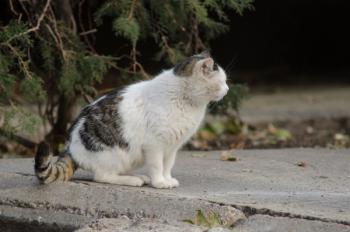
How do you manage congenital portosystemic shunts?
Signalment: Canine, Golden Retriever, 4 months old, female, 28 pounds. Clinical history: The puppy presents for vaccinations and has a potbelly.
Signalment:
Canine, Golden Retriever, 4 months old, female, 28 pounds.
Clinical history:
The puppy presents for vaccinations and has a potbelly.
Physical examination:
The findings include rectal temperature 102.2° F, heart rate 144/min, pink mucous membranes and normal capillary refill time. The puppy's panting and breathing made it difficult to actually hear the lung and heart sounds, but a grade 2/6 heart murmur is heard. The abdominal distension is noted to be palpable ascites. Abdominocentesis reveals clear fluid. The ECG shows a normal sinus rhythm.
Image 1.
Laboratory results:
A complete blood count, serum chemistry profile and urinalysis were performed and are presented in Table 1.
Radiograph examination:
The lateral abdominal radiograph shows the presence of severe ascites. The thoracic portion of the radiograph appears to be normal.
Ultrasound examination:
Thorough thoracic and abdominal ultrasonography was performed.
Comments:
There is a moderate amount of accumulated free fluid with fibrin tags present within the abdominal cavity. The liver shows a uniform echogenicity in its parenchyma. No masses noted within the liver parenchyma. The gall bladder is moderately distended, and its walls are not thickened or hyperechoic. The spleen shows a uniform echogenicity - no masses noted. The left and right kidneys are similar in size, shape and echotexture. No masses or calculi were noted in either kidney. The urinary bladder is distended with urine and contains some urine sediment material - no masses or calculi noted. The left and right adrenal glands are similar in size and shape. The stomach, small intestine and pancreatic region are normal. The echocardiogram is normal -- all heart valves are normal and Doppler flow across the pulmonary and aortic valves is normal.
Image 2.
Case management:
In this case, congenital portosystemic shunt is the clinical diagnosis. At this point, this puppy should be followed up with defining whether intrahepatic shunt or extrahepatic shunt is present.
Congenital portosystemic shunt
Congenital portosystemic shunts in puppies are usually single anomalous vessels in extrahepatic or intrahepatic locations. The consequences of the anomalous portal circulation are the portal blood contains toxins absorbed from the intestines that are delivered directly to the systemic circulation without benefit of hepatic detoxification, contributing to signs of hepatic encephalopathy and hepatotrophic factors in the visceral circulation. Draining the gastrointestinal tract and pancreas do not circulate directly to the liver, causing inadequate liver development and reduced functional liver tissue.
Image 3.
Signs of hepatic dysfunction associated with congenital portosystemic shunt are usually exhibited at a young age. Puppies may exhibit signs as early as 6- to 8-weeks of age. The signs in puppies are variable but may include vomiting, diarrhea, anorexia, small body stature, weight loss, intermittent fever, polyphagia, polydipsia, hematuria, hypersalivation, intolerance to anesthetic agents or tranquilizers that require hepatic metabolism or excretion, atypical behavior, and rarely ascites or icterus.
Intermittent neurologic abnormalities associated with ingestion of protein-laden food or resolving hemorrhage are common and may include episodic aggression, amaurosis, ataxia, incessant pacing, circling, head pressing and seizures. Some puppies are presented with ammonium biurate uroliths located in the urinary tract.
Image 4.
Definitive diagnosis of congenital portosystemic shunt in puppies is often not possible by routine laboratory evaluations. The CBC, serum chemistry profiles and urinalysis may help rule out other causes of presenting signs such as acute renal failure, electrolyte derangements, hypoglycemia and urinary tract disorders.
The CBC findings may include microcytic, normochromic erythrocytes and/or a mild nonregenerative anemia. Serum chemistry profiles may reveal mild increases in the serum activity of ALT, AST and ALP. In most animals with congenital PSS, the total bilirubin values are normal.
Image 5.
Albumin values may be mildly decreased. Coagulation profiles including prothrombin time, activated partial thromboplastin time and fibrinogen are usually normal. Serum glucose values may be normal, mildly reduced or markedly hypoglycemic. The BUN concentration may be low or in the low normal range in any young animal with hepatic dysfunction. The most reliable and consistent blood test for the detection of liver dysfunction in puppies with congenital portosystemic shunt is the 12- to 24-hour fasted and two-hour postprandial serum bile acid concentrations.
Diagnostic imaging
Diagnostic imaging of a puppy with abnormal serum bile acid values is to determine if a suspected congenital portosystemic shunt is present. Animals with congenital portosystemic shunt frequently have reduced hepatic size, i.e., rounded contour of the caudal edge of the liver and cranial displacement of the stomach radiographically.
Image 6.
In addition, these animals may have opaque ammonium biurate calculi. Ultrasonographic findings in puppies with congenital portosystemic shunt include small liver, reduced visibility of intrahepatic portal vasculature, and anomalous blood vessel draining into the caudal vena cava or sometimes into the azygos vein.
Two-dimensional, gray-scale ultrasonography is used to image through a ventral abdominal wall; however, in most large puppies the optimal approach to the portal vein is through a lateral abdominal wall using the right intercostal spaces.
The portal vein is normally visible by ultrasound imaging as ultrasound waves enter the liver at the porta hepatis, ventral to the caudal vena cava. Lobar branches of the portal vein have echogenic walls.
Congenital intrahepatic portocaval shunts are identified on the basis of their ultrasonographic appearance as left-divisional, central-divisional or right-divisional intrahepatic shunts. Left-divisional intrahepatic shunts have a relatively consistent bent tubular shape and drain into the left hepatic vein. Central-divisional intrahepatic shunts take the form of a foramen between dilated portions of the intrahepatic portal vein and caudal vena cava. Right-divisional intrahepatic shunts appear as large, tortuous vessels that extend far to the right of midline. The morphology of the left-divisional shunts is compatible with patent ductus venosus.
Results of laboratory tests
The Irish Wolfhound and Deerhound are predisposed to left-divisional intrahepatic shunts; the Old English Sheepdog and Australian Cattle Dog are predisposed to central-divisional intrahepatic shunts; Labrador and Golden Retrievers are affected by both left- and central-divisional intrahepatic shunts.
Animals with extrahepatic congenital portosystemic shunt typically have an anomalous vessel that drains into the caudal vena cava between the right renal vein and the hepatic veins; because of the dorsal location, this anomalous vessel may be visible only through the right dorsal intercostal spaces.
Congenital portoazygos shunts may also be visualized using the right dorsal intercostal approach, looking for the shunting vessel at the point where it drains into the caudal vena cava is more accurate than trying to examine the various tributaries of the portal vein.
Extrahepatic shunts may be difficult to identify ultrasonographically if access to the relevant structures is hindered by the skill level of the person doing the ultrasonographic study, animal's large body size, lack of acoustic windows as a result of reduced hepatic size, or presents with excessive intestinal gas and ascites.
Ancillary serum bile acids results.
Further details about congenital portosystemic shunts and their management in puppies are found in my textbook - Hoskins JD: The liver and pancreas. In Hoskins JD (ed): Veterinary Pediatrics: Dogs and Cats from Birth to Six Months, Third Edition. Philadelphia, WB Saunders Co., 2001, pp 200-224.
Dr. Hoskins is owner of DocuTech Services in Baton Rouge, La. He is a diplomate of the American College of Veterinary Internal Medicine with specialties in small animal pediatrics. Formerly a professor in the School of Veterinary Medicine at Louisiana State University, Hoskins is also the author of clinical textbooks on pediatrics and geriatrics. He founded an Internet service called "Vet-Web.com", where pet owners can e-mail animal health-related questions and he responds via e-mail. The Internet address is www.vet-web.com. He can be reached at (225) 751-9272.
Newsletter
From exam room tips to practice management insights, get trusted veterinary news delivered straight to your inbox—subscribe to dvm360.






